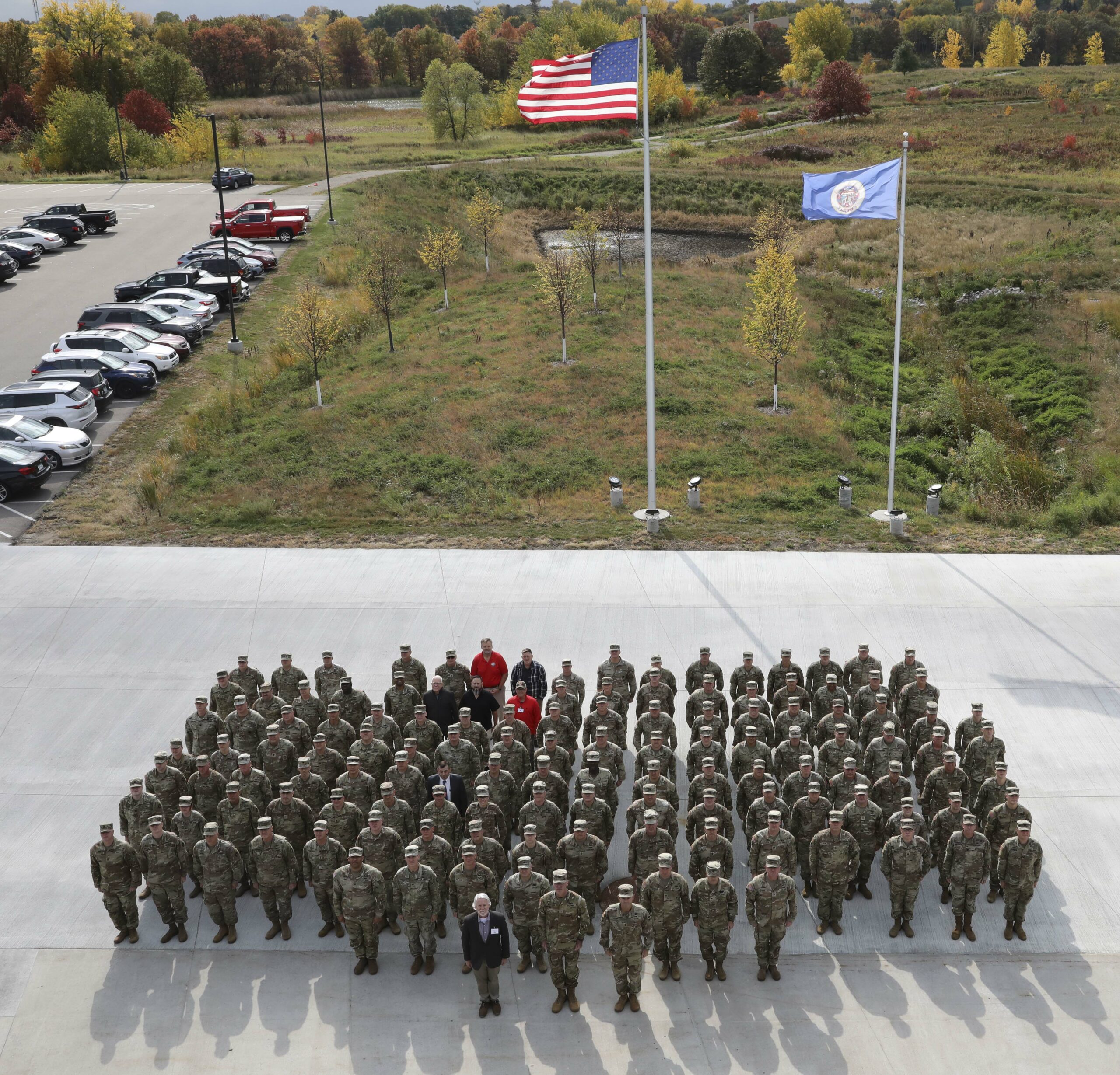Minneapolis Military Base - On Sunday, about 150 members of the Minnesota National Guard will deploy to Naval Station Guantanamo Bay, where they will be tasked with providing basic security.
About 150 soldiers from the 34th Military Police Company, based in Stillwater, will first receive additional training at Fort Bliss, Texas, before heading to the southeast coast of Cuba.
Minneapolis Military Base

"Our Soldiers are trained and motivated for this important mission," said company commander Capt. Troy Davidson. "Over the past several years, we have worked hard to ensure that this unit is one of the most ready units in the United States Army."
Dark Minneapolis Blog
Normally, the induction ceremony would be held on the day of departure from Minnesota, but due to COVID-19 restrictions, there will be a Sunday ceremony at 1 p.m. and is available for viewing by the general public on the Minnesota National Guard Facebook page.
Since September 11, 2001, it has deployed members of the 34th Military Police Company to Bosnia, Kosovo, Afghanistan and Iraq.
In response to the incident, Valley Crossing Elementary School asked parents to escort their children to safety information.
The military presence in the Twin Cities drew residents in, but the decision to ask them to leave drew criticism from Gov. Tim Walls and Republican Party leaders. This article is about the historic military fort. For the unit of the Minnesota State Park System, see Fort Snelling State Park. For other uses, see Fort Snelling (disambiguation).
Minnesota Military Museum
This article has an ambiguous citation style. References used may be explained in a different or consistent style of citations and footnotes. (November 2020) (Learn how and how to remove this message template)
44°53′34″N 93°10′50″W / 44.89278°N 93.18056°W / 44.89278; -93.18056 Coordinates: 44°53′34″N 93°10′50″W / 44.89278°N 93.18056°W / 44.89278; -93.18056
Fort Snelling is a former military fort and National Historic Landmark on the bluffs overlooking the confluence of the Minnesota and Mississippi rivers in the US state of Minnesota. The military base was originally called Fort Saint Anthony, but after construction was completed in 1825, it was renamed Fort Snelling.

Before the American Civil War, the US Army supported slavery at the fort by allowing its soldiers to bring their own personal slaves. Among them are Dred Scott and Harriet Robinson Scott, African-Americans who lived in the fort in the 1830s. In the 1840s, Scots sued for their freedom, claiming they were freed because they lived on "free land" in the landmark US Supreme Court case Dred Scott v. Sandford led the case. Slavery in a fort before the statehood of Minnesota in 1858
Air Force Official Fired After 6 Nukes Fly Over U.s
The fort served as the main fort for US government troops during the Dakota War of 1862. It was also the location of a camp where East Dakota and Ho-Chunk non-combatants awaited transport by riverboats during the forced evacuation from Minnesota when hostilities broke out. ceased. The fort served as a recruiting station in the Civil War, the Spanish-American War, and both World Wars before being evacuated a second time in 1946. It fell into disrepair until the lower pillar was restored to its original form in 1965. At that time, only the round and hexagonal pillars remained of the original lower pillar. Many important buildings of Zgornje stebra are still standing today, some are still decaying.
The historic fort is located in the unincorporated area of Fort Snelling in Hennepin County, bordering Ramsey and Dakota counties.
There are now several government agencies that own parts of the old fort, including the Minnesota Historical Society, which operates the Fort Snelling Historic Site. The Minnesota Department of Natural Resources manages Fort Snelling State Park at the base of the bluff. Fort Snelling once marked the park area. It has been listed as a "National Treasure" by the National Trust for Historic Preservation.
The Dakota-Glish Dictionary (1852), edited by missionary Steph Return Riggs, originally recorded the word as mdóte, noting that it was “a name commonly applied to the country about Fort Snelling or the mouth of St. Peter. "
Minneapolis Moline Power Unit
Now known as the Minnesota River. According to Riggs, "The Mdewakantonwan think that the mouth of the Minnesota River is exactly above the center of the earth, and that they have a gateway to the western world."
The confluence of the Minnesota and Mississippi rivers also became the place where Native Americans signed treaties with the United States: the Treaty of St. Peters of 1805, signed by the Mdewakanton Dakota, the White Pine Treaty of 1837, signed by several Ojibwe bands, and the 1851 Representatives of the Mdewakanton and Wahpekute Dakota. Mdota signed the agreement
In 1805, Lt. Zebulon Pike signed an unauthorized incorporation treaty known as Pike's Purchase (Treaty of St. Peter 1805). Of the South Dakota members present, only two signed: Seaton Wakua Mani (Petit Kobo) and Way Aga Ogie (Wenyaga Inasin). It surrendered 155,320 hectares of land in the area.

Article One - Grants the Sioux Nation to the United States nine square miles at the mouth of the St. Croix, below the confluence of the Mississippi and St. Peters, in Mississippi, for the purpose of establishing military posts. Enter the Falls of St. Anthony, stretching nine miles on both sides of the river.[9]
Remembering Martin, A Mlk Day Observance
Although Pike was a military officer, he had no authority to sign the treaty on behalf of the United States and had no official witnesses.
Pike Tire was recast as a treaty negotiated with the Sioux Nation, but was actually signed only by representatives of the two Mdewakanton villages.
From a legal point of view, the description of the land that the signatories intended to offer was insufficient.
Pike wrote in his diary that he thought the land was worth US$200,000, but left the payment blank in the contract itself.
File:observation Squadron 7, Minneapolis, Minnesota, 1934 (7893906456).jpg
On April 16, 1808, the U.S. When Sate finally approved the treaty, he only approved a payment of $2,000 to the Dakota.
Payment for the ceded lands did not come until 1819, when St. Major Thomas Forsyth of the United States War Department delivered about $2,000 in goods.
In 1838, Indian Agt Lawrce Taliaferro attempted to settle the issue with other Dakota bands by paying an additional $4,000, but the issue continued to arise in subsequent treaty negotiations in the 1850s.
After the War of 1812, the US War Department built a chain of forts and installed Native American defenses from Lake Michigan to the Missouri River in South Dakota. These forts were intended to extend the United States into the Northwest Territories under the Treaty of Ght and to demarcate the 49th parallel. The treaty restricted British-Canadian traders from operating in the United States and was intended to force Indian territories to remain free of white settlement until such time as the fort treaty permitted. Forts were the epitome of federal authority, representing law and order to protect pioneers and traders.
Dbids Identity Verification Sytem Debuts At Msp Air Reserve Station > Minneapolis St Paul Air Reserve Station > Article Display
The Anglo-Europeans called the Minnesota River St. Peters, and the Indians were part of Fort Snelling from 1820 to 1853.
In 1819, Lt. Col. Henry Leaveworth commanded the 5th Infantry Expeditionary Force, which built the initial outpost. The canton was called "New Hope" and was on the plains along the Minnesota River. That winter, Colonel Leaveworth lost 40 m to scurvy and moved his camp to Coldwater Camp, which he believed contributed to the spread of the river.
The new camp was near a spring near the fort he was building. The spring was said to be the building's source of drinking water throughout the 19th century. Spring had spiritual significance for the Sioux. In January 1820, the post-surgeon began recording meteorological observations in the fort. US Army Surgeon General Gerald assigned the surgeon at each military station to record four weather readings each day.
In 1820, Colonel Josiah Snelling was in command of the post and construction of the fort. After its completion in 1824, he named his work "St. Anthony's Fort" for the waterfalls upstream. It didn't take long for it to be renamed Fort Snelling to acknowledge the fort's architect, Gerald Winfield Scott.
Cpi Innovates, Improves Processes At Mcchord Field
Plus a company from the 1st Dragoons. In 1827, the 5th Infantry Regiment will replace the 1st Infantry Regiment for 1837 with the 5th Infantry Regiment.
The 5th would defend the fort until the 1st replaced them again in 1840. In 1848 the 6th Infantry became the fort.
In November 1855, the fort will change again. Colonel C.F. On the 10th, Smith took command. Smith would become the main geralt.

Colonel Snelling was recalled to Washington in September, 1827, and left Fort Snelling. He died the following summer from complications of dysentery and "brain fever."
U.s. Military Bases In The Path Of Hurricane Ian
In 1827 Minnesota's first post office was established at Fort Snelling and most of the mail was routed from Prairie du Chi.
In 1828, Colonel Zachary Taylor took command. He observed that "the buffaloes are exhausted, and the bears and deer very scarce." He wrote that “Indians live primarily
Military drone range, laser range finder military, military range bags, military range targets, long range military radio, military radio range, military range finder, military long range binoculars, range rover military discount, military range rover, range of military drones, military range bag

0 Comments